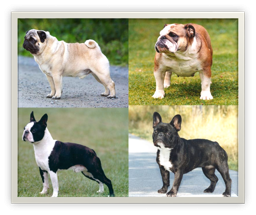The first formal paper from the Cambridge study mentioned in another article in The Brachycephalic Issue was published in June:
Characterisation of Brachycephalic Obstructive Airway Syndrome in French Bulldogs Using Whole-Body Barometric Plethysmography.
See the Abstract (below).
This work offers exciting new possibilities to advance health and welfare in brachycephalic breeds.
Abstract
Brachycephalic obstructive airway syndrome (BOAS) is an important health and welfare problem in several popular dog breeds. Whole-body barometric plethysmography (WBBP) is a non-invasive method that allows safe and repeated quantitative measurements of respiratory cycles on unsedated dogs. Here respiratory flow traces in French bulldogs from the pet population were characterised using WBBP, and a computational application was developed to recognise affected animals. Eighty-nine French bulldogs and twenty non-brachycephalic controls underwent WBBP testing. A respiratory functional grading system was used on each dog based on respiratory signs (i.e. respiratory noise, effort, etc.) before and after exercise. For development of an objective BOAS classifier, functional Grades 0 and I were considered to have insignificant clinical signs (termed here BOAS-) and Grades II and III to have significant signs (termed here BOAS+). A comparison between owner-perception of BOAS and functional grading revealed that 60 % of owners failed to recognise BOAS in dogs that graded BOAS+ in this study.WBBP flow traces were found to be significantly different between non-brachycephalic controls and Grade 0 French bulldogs; BOAS- and BOAS+ French bulldogs. A classifier was developed using quadratic discriminant analysis of the respiratory parameters to distinguish BOAS- and BOAS + French bulldogs, and a BOAS Index was calculated for each dog. A cut-off value of the BOAS Index was selected based on a receiver operating characteristic (ROC) curve. Sensitivity, specificity, positive predictive value, and negative predictive value of the classifier on the training group (n=69) were 0.97, 0.93, 0.95, and 0.97, respectively. The classifier was validated using a test group of French bulldogs (n=20) with an accuracy of 0.95. WBBP offers objective screening for the diagnosis of BOAS in French Bulldogs. The technique may be applied to other brachycephalic breeds affected by BOAS, and possibly to other respiratory disease in dogs.
 Donate
Donate
Recommended Comments
There are no comments to display.
Join the conversation
You can post now and register later. If you have an account, sign in now to post with your account.
Note: Your post will require moderator approval before it will be visible.